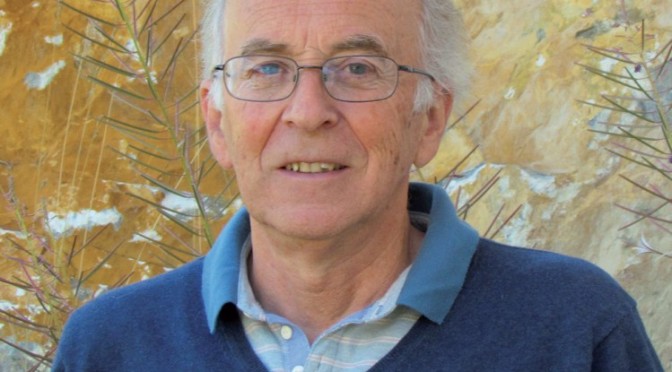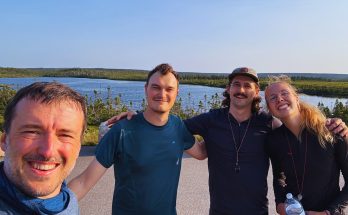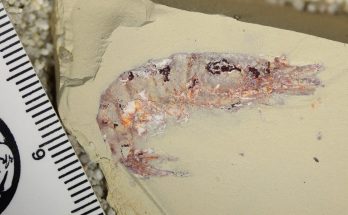Cette publication est également disponible en :
![]() English
English

Gérard Stampfli, géologue et Prof. honoraire de la FGSE, a reçu fin 2014 la prestigieuse médaille de Leopold von Buch (Société Géologique d’Allemagne) pour l’ensemble de sa carrière. Retour sur un parcours d’exception.
Presenting Gérard Stampfli, I had the pleasure to collaborate with him during the last 20 years. Trying to understand plate tectonic reconstructions, I had to learn that this is just not « moving basement pieces around the globe », but to find the geographic coordinates for a past time period, where an assemblage of data and observations would fit best the given geological framework.
Born in Pont-l’Evêque (Calvados, France) on 23. February 1949, Gérard Stampfli obtained in 1973 his master in Earth-Sciences at the Department of Geology and Paleontology, University of Geneva/Switzerland, and concluded his studies in the NE Alborz range (Iran) with his PhD thesis in 1978: Etude géologique générale de l’Elbourz oriental au sud de Gonbad-e-Qabus (Iran NE).
His scientific career, then, led him from 1978 to 1987 to Shell International, where he acquired his wide knowledge and experience as seismic interpreter and basin analyst in the Shell main office, The Hague, and subsequently in Borneo and New Zealand, and continued subsequently in the Shell research centre Rijswijk in charge of the 3D seismic interpretation development, before he became team leader for the Gulf of Suez team in Cairo.
Since 1987, Gérard was nominated Professor at the University of Lausanne, Institute of Geology and Paleontology, in charge of general geology, geodynamics, 3D seismostratigraphy and sequential stratigraphy, basin analysis and dynamics, and post grade courses and field trips on Tethyan geology.
During all these years, Gérard participated and organised many national and international scientific conferences and lectures, acted often as key-note speaker, and was responsible in International Geological projects like IGCP 369 (Peritethys Rift Basins, 1994?1999), the TRANSMED Project IGC 2004, Florence, and ELD, Europrobe project on the dynamics of Europe, 2006.
Gérard, consequently, spent most of his lifetime as a geologist, and mostly together with his PhD-students, to gather in the field evidences for the existence of Tethyan oceans, and specifically for the definition of Palaeotethys and Neotethys. Beginning in Geneva with his PhD in Iran, he already dug out in 1978 convincing evidence of what had to become the first step in defining Palaeotethys.
At present, its existence is not to be demonstrated anymore, and about a dozen of reviewed publications on this subject with numerous field data can no more be discarded nor ignored. The fauna and stratigraphy, the evolution in space and time, the suture with the seamounts, the ophiolites, all presenting evidences for the northern margin of Palaeotethys, the observations covering the areas from China to Thailand, the Himalaya, Afghanistan, Iran, to Turkey, Greece and Italy. Nice evidences of the Palaeotethys’ southern margin were found in the Moroccan Anti-Atlas and Meseta, and will certainly be proven even in Spain.
A new door opened since 1996, when including the evolution of the Gondwana margin in the frame of the Intra-Alpine terrain. The input of new data for the pre-Mesozoic basement during my regular visits at Lausanne resulted in the present-day models on the geodynamic evolution of the Gondwana margin in the frame of its worldwide plate-tectonic situation. I remember well, how all these new data were digested in the working group, and that even my bad understanding as a hard-rock geologist would not hinder Gérard, to repeat patiently, why certain models would not work, and why there were only specific reasons, how to see the plate-tectonic evolution through time. I also learnt, that the so-called “Steinmann trilogy”, the beloved model for the evolution of oceanic crust, had to be replaced by thinking in a multivariate evolution model through time, remaining probably like a 3D-web in Gerard’s mind, I suppose. How to communicate such multivariate knowledge, when we have still difficulties to see such models in two dimensions and on a geographic map ?
It is consequently a great pleasure for me to present Gerard Stampfli as the 2014 recipient of the Leopold von Buch medal. With my congratulations!
Jürgen F. von Raumer
Fribourg/Switzerland


